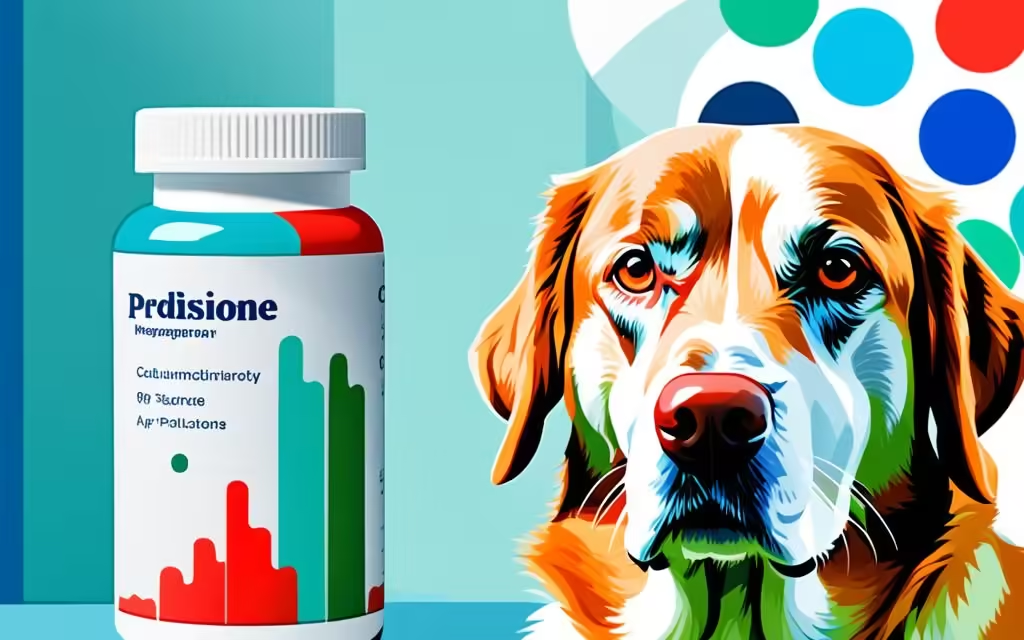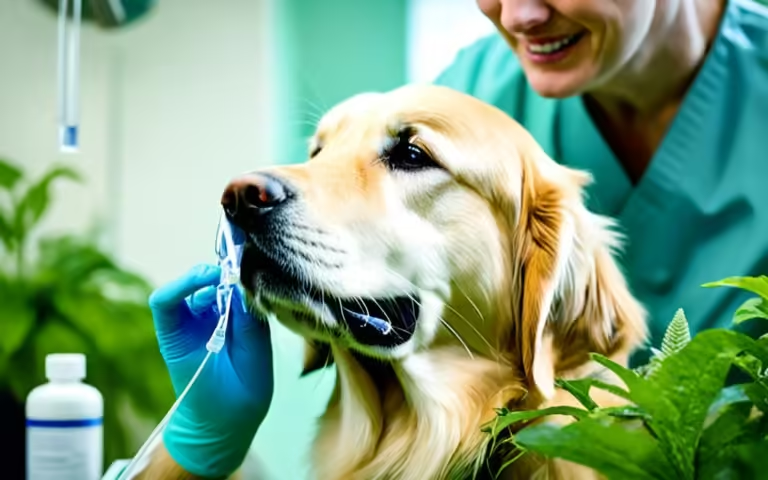Prednisone and Prednisolone for Dogs: Uses & Effects
Did you know that over 10 million dogs in the United States get prednisone or prednisolone every year? These medications are key in veterinary care. They help fight inflammation and weaken the immune system. But, using them for too long or in the wrong way can cause big problems123.
Key Takeaways
- Prednisone and prednisolone are widely used in dogs to manage inflammation, allergies, autoimmune disorders, and other conditions.
- Short-term use can cause side effects like vomiting, diarrhea, and lethargy, while long-term use may lead to more serious issues like diabetes and weakened immune system.
- Dosage and duration of treatment must be carefully monitored by veterinarians to minimize risks and optimize therapeutic benefits.
- Prednisone is quickly converted to prednisolone in the liver, so they are considered bioequivalent for most clinical applications.
- Proper administration and gradual tapering of these medications is crucial to avoid withdrawal complications in dogs.
Table of Contents
What are Prednisone and Prednisolone?
Prednisone and prednisolone are synthetic corticosteroids, a type of glucocorticoid4. Prednisone turns into the active form, prednisolone, in the liver5. They are seen as the same drug because of this change6.
Understanding the Drugs’ Nature
Prednisone and prednisolone are glucocorticoids used for dogs and cats4. They help reduce inflammation but can also cause side effects4.
Differences and Similarities Between the Two
Prednisone can’t be used in cats and horses, unlike prednisolone5. Prednisone comes in various strengths for dogs, including tablets and syrup5. Prednisolone is only available in 5 mg and 20 mg tablets for pets5.
Both drugs are used for reducing inflammation, like joint pain and itchy skin in dogs5. They are also used to calm an overactive immune system5.
“Prednisone and prednisolone are synthetic corticosteroids that can be used to treat a variety of conditions in dogs, but they also come with potential side effects that owners should be aware of.”
In summary, prednisone and prednisolone are similar drugs because of the liver conversion. The main difference is prednisolone works for cats and horses, not prednisone. Both have the same uses but differ in how they are given654.
Common Uses of Prednisone and Prednisolone for Dogs
Prednisone and prednisolone are often given to dogs as immunosuppressant drugs. They help manage many health issues in dogs7. These drugs are strong anti-inflammatory and immunosuppressive agents. This makes them key in veterinary care.
Anti-inflammatory Properties
Prednisone and prednisolone are mainly used to treat inflammation in dogs7. They lessen pain, swelling, and other symptoms of inflammation. This includes issues like allergies, skin problems, and joint issues7. Vets can give these drugs by mouth, injection, or on the skin7.
Immunosuppressive Effects
Prednisone and prednisolone also help with autoimmune diseases and some cancers in dogs7. These conditions happen when the immune system attacks the body’s own tissues. These drugs can calm down this overactive immune response8. In some cases, prednisone can even put lymphoma and mast cell tumors into remission alone8. It also helps improve symptoms and quality of life in dogs with cancer8.
But, it’s important not to give these drugs to dogs with Cushing’s disease. It could make things worse7. It’s also crucial to watch the dosage and monitor the dog closely to avoid side effects83.

“Prednisone and prednisolone are powerful tools in the veterinary arsenal, but they must be used judiciously to ensure the best outcomes for our canine patients.”
Prednisone and prednisolone are crucial for treating many health issues in dogs. They help with allergies, skin problems, autoimmune diseases, and cancer783.
Prednisone and Prednisolone for dog Conditions
Prednisone and prednisolone are often given by vets to treat many dog conditions. They are great for allergies, skin issues, autoimmune diseases, and hormonal problems9.
Allergies and Skin Conditions
These drugs can really help dogs with allergies or skin problems. They reduce swelling and ease itching by calming the immune system’s overactive response9. Vets might give a short course of these meds, then slowly reduce the dose to avoid side effects10.
Autoimmune Disorders
For dogs with autoimmune issues, prednisone and prednisolone are key. They stop the immune system from attacking the body. This helps reduce symptoms and protects organs9. It’s important to watch the dog closely and adjust the dose to balance treatment with safety10.
Hormonal Imbalances
These drugs can also fix hormonal problems like Addison’s disease, where the body lacks natural corticosteroids. They help bring hormone levels back to normal, easing symptoms9. Dogs might need a regular dose of these meds, with vet checks to keep the dosage right10.
Using prednisone and prednisolone in dogs needs careful watching and adjusting the dose. Too much or too long can cause side effects. Regular vet visits and blood tests are key for safe use10.
Knowing how prednisone and prednisolone help dogs with different conditions helps owners and vets care for their pets better11.
Dosage and Administration Guidelines
Figuring out the right dose of prednisone and prednisolone for dogs is key12. These medicines come in tablets, liquids, and shots12. The vet will decide the dose based on the dog’s size and the health issue.
For allergies and skin problems like atopic dermatitis, vets might start with 0.5 to 1 mg/kg of prednisolone a day12. If the dog is getting worse fast because of a lot of scratching and injury, they might need more medicine at first12. For conditions like immune-related anemia and lupus, the dose could be 1 to 2 mg/kg of prednisolone12.
Prednisone and prednisolone are much stronger than the body’s natural cortisol11. They’re not approved by the FDA for pets but are made by special pharmacies11.
How often you give the medicine can change, based on the dog’s needs and the vet’s advice12. How long the treatment lasts also depends on how the dog responds and the condition being treated.
| Medication | Dosage Form | Typical Dose Range |
|---|---|---|
| Prednisone | Tablet | 2.5 mg – 20 mg per dose13 |
| Prednisolone | Tablet, Oral Liquid, Injectable | 0.5 mg/kg – 2 mg/kg per day12 |
It’s crucial to watch the dosage and how often you give prednisone and prednisolone to dogs closely11. The vet will adjust it to get the best results and avoid side effects11.
“To make prednisolone safer, use the lowest dose needed, try different schedules, keep the treatment short, stop if side effects are bad, go to regular vet check-ups, and use other treatments like baths, flea control, creams, or special diets.”12
Potential Side Effects and Precautions
Prednisone and prednisolone are often used to treat dogs, but they can have side effects. These effects can be short-term or long-term6. It’s important for pet owners to know these risks and work with their vets to manage them.
Short-Term Side Effects
Short-term side effects include increased thirst, urination, appetite, and panting612. These symptoms start soon after the dog begins treatment and can last as long as the medication is used.
Long-Term Side Effects
Using prednisone and prednisolone for a long time can cause serious side effects612. These can include symptoms like hair loss, muscle wasting, and a pot-bellied look612. These drugs can also increase the risk of stomach ulcers and weaken the immune system, making dogs more likely to get infections612.
“Veterinarians carefully weigh the benefits and risks when prescribing these medications and closely monitor dogs for any adverse reactions.”
But, serious side effects from prednisone are rare14. The risk depends on the dosage, how long the dog takes the medication, its age, and other health issues14.
Vets think carefully about the risks and benefits of these drugs and watch dogs for side effects612. Knowing about possible side effects and taking steps to prevent them helps make sure these drugs are used safely and effectively for dogs61214.
Drug Interactions and Monitoring Requirements
Prednisone and prednisolone are strong medicines that can work with other drugs. It’s important for vets to know all the meds a dog is on. This helps make sure these steroids are used safely and work well15. These medicines might interact with painkillers, some antibiotics, and vaccines15. Watching closely is key when using them to help a dog’s health.
Vets might suggest blood tests and urinalysis to check how these treatments are working15. This helps them change the dose if needed and spot any side effects early15. The type of tests and how often they’re done will depend on the dog and its condition.
- Blood tests look at the dog’s overall health, like liver and kidney function, and check for signs of infection or swelling15.
- Urinalysis can find changes in the dog’s urine, like more sugar or protein, which could mean the medicine is causing problems15.
Vets will watch for signs of side effects, like more thirst, peeing, eating, restlessness, and panting15. Using prednisone or prednisolone for a long time or in high doses can cause bigger issues, like weight gain, stomach problems, hair loss, and liver issues15. It’s important to watch closely and adjust the dose to lessen these risks.
“Stopping prednisone suddenly can cause withdrawal symptoms because the adrenal glands make less cortisol.”15
Vets will work with pet owners to make sure prednisone or prednisolone is used safely and effectively. They’ll tailor the treatment and watch for any signs of worry.

Prednisone and Prednisolone for Dogs: Uses & Effects
Prednisone and prednisolone are key medicines in vet care for dogs. They help with inflammation16 and fight autoimmune diseases and some cancers11. Vets must weigh the good and bad when giving these drugs, as they can affect dogs in the short and long term16.
For dogs, vets might use prednisone, prednisolone, dexamethasone, triamcinolone, and methylprednisolone16. These drugs are much stronger than natural ones and last longer16. When used right, they’re safe. But, using them for a long time or in high doses can cause big health problems16.
A 30-day supply of prednisone for dogs costs about $7 to $156. It’s often used to treat dog allergies6. Dogs might get thirsty, pee more, eat more, gain weight, feel restless, and heal slower on prednisone6. These issues usually go away after the treatment ends. But, using it for a long time can cause bigger problems6.
Prednisone and prednisolone are four times stronger than natural cortisol in fighting inflammation11. They’re not officially approved by the FDA for pets, but vets use them11. Giving these drugs for a short time is usually safe. But, the longer and higher the dose, the more risks there are11.
In summary, prednisone and prednisolone are important in vet care, but they need careful use. The right dose, how you give it, and regular vet checks are key to keeping dogs safe and healthy16611.
Comparing Prednisone and Prednisolone to Other Corticosteroids
Prednisone and prednisolone are top choices for vets when treating pets. They are similar but have key differences compared to other options for dogs.
Efficacy Comparisons
Prednisone and prednisolone work well against inflammation and help suppress the immune system17. Prednisolone is better for cats and horses because they can’t change prednisone into its active form17. Also, prednisolone is better absorbed when given as a slurry17.
Cost and Availability
The choice between these drugs also depends on cost and where you can get them18. Both prednisone and prednisolone are affordable and easy to find, but prices and availability can change based on where you live and your healthcare setup. Vets look at all these factors to pick the best steroid for a dog’s needs.
| Corticosteroid | Efficacy | Cost | Availability |
|---|---|---|---|
| Prednisone | Comparable to prednisolone17 | Affordable | Widely available |
| Prednisolone | Comparable to prednisone, with superior enteral absorption17 | Affordable | Widely available |
| Dexamethasone | Potentially more potent, but with different pharmacokinetics | Affordable | Widely available |
| Methylprednisolone | Comparable to prednisone and prednisolone | Moderately priced | Widely available |
In summary, while prednisone and prednisolone are great for dogs, vets might choose other options too. They look at how well a drug works, its price, and if it’s easy to get171819.
Safe Usage and Tapering Guidelines
Using prednisone and prednisolone safely is key for our dogs’ health20. Vets use these drugs for many issues like inflammation and allergies20. Always follow your vet’s advice to use them right.
Getting the dosage right and tapering slowly is important20. Vets set the right dose for your dog’s needs21. Always give the medicine as told and don’t stop it suddenly to avoid problems20.
Tapering means slowly reducing the dose to help your dog adjust20. Vets will tell you how to taper, based on your dog’s health and treatment length21. It’s key to follow these tapering steps carefully.
Don’t stop these medicines suddenly, as it can cause stomach issues and more20. Following the vet’s tapering advice helps your dog stop the medicine safely.
Being responsible with prednisone and prednisolone is crucial for our dogs20. By following the vet’s advice on dosage and tapering, you help your dog get the best care202122.
When to Consult a Veterinarian
When giving your dog prednisone, prednisolone, or any other medicine, always talk to a vet4. Vets can figure out what’s wrong, decide the right dose, and watch how your dog reacts to the treatment4.
If your dog shows side effects like drinking more, peeing more, eating more, or panting, call your vet right away4. Long-term use of steroids can cause serious problems like muscle loss, stomach issues, skin changes, diabetes, heart disease, and more infections4.
Talk to your vet if your dog’s health changes or if you need to add new medicines4. Don’t mix steroids with NSAIDs in dogs because it can cause serious stomach problems and bad reactions4.
Watching your dog closely, giving the medicine right, slowly stopping it, and knowing the side effects are key when using prednisone or prednisolone for your dog4. Working with your vet helps make sure these medicines are used safely and work well for your pet4.
Prednisolone can also help treat cancer in pets, but don’t give it with NSAIDs like piroxicam because it can cause serious stomach ulcers23. Piroxicam can fight cancer in dogs and cats safely, with some mild side effects23.
Prednisone can be used quickly for things like anaphylactic shock or hives, or for longer to treat Addison’s Disease24. But, don’t give it to dogs with certain health issues like fungal infections, heart disease, diabetes, or kidney disease24.
If your vet suggests prednisone, prednisolone, or another medicine for your dog, follow their advice closely and watch your pet carefully42324. Working with your vet ensures these medicines are used safely and effectively, giving your pet the best care42324.
Conclusion
Prednisone and prednisolone are key medicines for dogs with many health issues25. They help with allergies, skin problems, autoimmune diseases, and some cancers. These drugs have strong anti-inflammatory and immune system effects25.
It’s important for dog owners to work with their vets when using these medicines. They need to follow the right dosage and watch for side effects26. With a vet’s advice, dog owners can keep their pets healthy.
Important points from this discussion are the wide use of these drugs, the need for a vet’s advice, and watching for side effects2625. Knowing how to use these medicines helps dogs stay healthy and happy.
FAQ
What are prednisone and prednisolone?
What are the common uses of prednisone and prednisolone for dogs?
How are prednisone and prednisolone used to treat specific dog conditions?
What are the dosage and administration guidelines for prednisone and prednisolone in dogs?
What are the potential side effects and precautions associated with prednisone and prednisolone use in dogs?
How do prednisone and prednisolone interact with other medications, and what are the monitoring requirements?
How do prednisone and prednisolone compare to other corticosteroids used in veterinary medicine?
What are the guidelines for safe usage and tapering of prednisone and prednisolone in dogs?
When should a dog owner consult a veterinarian about the use of prednisone and prednisolone?
Source Links
- What to Know About Prednisone for Dogs
- Prednisolone for Dogs: Uses, Side Effects, and More – GoodRx
- Prednisolone/Prednisone | VCA Animal Hospitals
- Prednisone (Prednisolone) For Dogs: Uses, Dosage, Side Effects
- Prednisolone/Prednisone
- Prednisone for Dogs: How and Why It’s Administered – GoodRx
- Prednisone for Dogs – Is It Safe? Find Out! | Purina
- Prednisone for Dogs: Uses, Side Effects, Helpful Tips
- Prednisone / Prednisolone for Dogs and Cats – PetPlace
- How to manage prednisone side effects in dogs
- Uses, Dosage & Side Effects
- Prednisolone In Dogs | Side Effects & Dosage | Walkerville Vet
- What You Need to Know
- Prednisone Oral Tablet: Side Effects, Uses, Dosage, and More
- What To Expect if Your Dog Is on Prednisone
- Steroid Treatment – Effects in Dogs | VCA Animal Hospitals
- Comparative Serum Prednisone and Prednisolone Concentrations following Prednisone or Prednisolone Administration to Beagle Dogs
- Frontiers | Pharmacokinetics of Oral Prednisone at Various Doses in Dogs: Preliminary Findings Using a Naïve Pooled-Data Approach
- Pharmacokinetics of Oral Prednisone at Various Doses in Dogs: Preliminary Findings Using a Naïve Pooled-Data Approach
- Prednisone and Prednisolone for Dogs and Cats
- Prednisone (Prednisolone) For Dogs: Uses, Dosage, Side Effects
- Prednisone For Dogs: Safe Dosages And Uses
- Prednisolone & Piroxicam in Dogs & Cats with Cancer – The Pet Oncologist
- Prednisone for Dogs | Wag!
- Prednisone in Dogs
- Perception and usage of short-term prednisone and prednisolone in dogs







